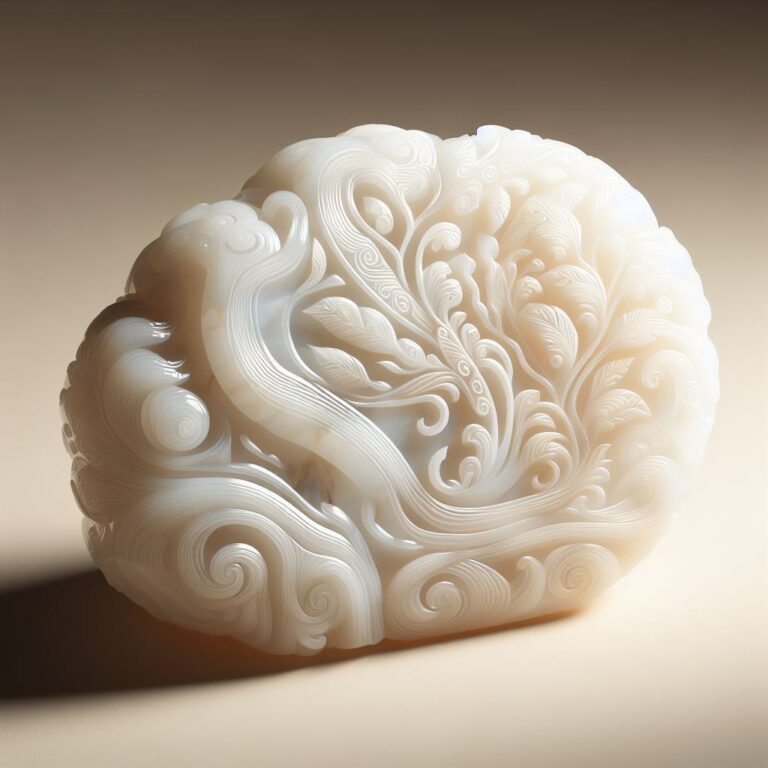Sanpanku Eyes Spiritual Meaning: More Than Meets The Eye
Have you ever noticed someone with an intense gaze that seems to stare right through you? Or maybe you’ve spotted eyes that appear encircled by white? If so, you may have encountered the phenomenon of sanpanku eyes.
Here’s a quick interpretation:
The spiritual meaning of sanpanku eyes relates to extra visible white of the sclera around the colored iris, often linked to strong yin/yang energetic qualities. In Eastern face reading, sanpanku eyes indicate a profound connection to intuitive and metaphysical realms, with the potential for both visionary mystical gifts and emotional volatility requiring self-mastery.

A Mystical Look
In Japanese, sanpanku translates to “three whites”. It refers to eyes that have sclera visible on three sides of the colored iris. Usually, it means:
- Extra white underneath the iris
- Extra white on top of the iris
- Or extra white on the left and right sides
So in other words, the iris floats in a sea of white!
The sanction look lends an otherworldy, mesmerizing quality. When you meet someone with pronounced sanpanku eyes, you’ll likely find them hard to ignore.
Table: Different Types of Sanpanku Eyes
| Name | Description |
|---|---|
| Lower sanpanku | Extra white visible below iris |
| Upper sanpanku | Extra white visible above iris |
| Lateral sanpanku | Extra white on the left and right of iris |
Sanpanku eyes are often inherited. Medically, they arise from genetic conditions like Waardenburg syndrome or oculocutaneous albinism that affect pigmentation and development of the iris.
But beyond medicine and genetics, sanpanku eyes are shrouded in spiritual mystique and intrigue. Let’s uncover their symbolic secrets!
Eyes as Windows to the Soul
There’s a reason the eyes are called the windows to the soul. Many cultures recognize eyes as gateways to reading someone’s true nature and hidden depths.
Likewise, Japanese and Chinese face reading traditions see sanpanku eyes as reflections of the wearer’s spiritual identity and life path.
So what do different sanpanku eye patterns indicate energetically?
Lower Sanpanku
In Macrobiotic philosophy, lower sanpanku eyes with extra sclera beneath the iris represent valuable yin energy.
Yin energy is:
- Receptive
- Intuitive
- Compassionate
- Spiritually inclined
People with lower sanpanku eyes are thought to be old, wise souls who easily connect with spirits, visions and metaphysical energy.
They act as natural healers, counselors and givers of solace. Their spiritual gifts nurture and sustain communities.
Upper Sanpanku
By contrast, Japanese face reading links upper sanpanku eyes that show additional white above the iris with intense yang energy.
Properties of yang energy include:
- Ambition
- Action
- Aggression
- Visionary leadership
Folks with upper sanpanku eyes are trailblazing go-getters who forge new paths, think outside boxes and inspire others to follow suit. Their incredible drive may also spur restlessness, conflict and control issues however.
So in essence, lower sanpanku = yin while upper sanpanku = yang.
The Infamous “Sanpaku Death Sentence”
In 1965, famed Japanese macrobiotic health expert George Ohsawa brought sanpanku eyes into Western awareness. He made a startling pronouncement about their meaning.
Ohsawa declared that anyone with sanpanku eyes “is not long for this world” and fated for an early demise.
He believed the anomaly destined people to die prematurely by:
- Suicide
- Homicide
- Sudden or “unnatural” causes
This grew into an urban legend dubbed the “sanpaku death sentence”. For decades, many took Ohsawa’s warning as fact.
Sanpaku eyes became associated with famous musicians, artists and celebrities who died young like Elvis Presley, John Lennon, Marilyn Monroe, Bruce Lee and more.
Were sanpanku eyes to blame? Or is it all coincidence and confirmation bias?
Shedding Light on Sanpanku Stigma
While bereaved fans blamed sanpanku eyes for their idols’ untimely loss, other evidence contradicts the gloomy myths.
- Plenty of sanpanku eyed folks enjoy long, healthy lifespans without meeting “early graves”
- No reputable studies scientifically link the condition to reduced longevity
- It’s a predominantly Asian anomaly, so numbers likely seem higher due to confirmation bias and small sample sizes of famous Western cases.
So what explains the Madonna/Monroe-effect of allocating deeper meaning to the deaths of talented, charismatic famous people?
Our minds tend to notice and assign symbolic importance to strange coincidences…even when they reflect statistical probabilities more than mystical omens.
Rationally, no eye shape robs anyone of free will or predestines them to die before average life expectancy.
Yin-Yang Balance: Holistic Sanpanku Perspectives
Rather than death sentence, native Asian philosophy frames sanpanku eyes from a holistic yin/yang standpoint.
This lens views them not as curses but as indicators of two pathways a person can walk, both equally valid.
1. Spiritual Insight Path
First, sanpanku eyes may represent a path of spiritual insight and visionary guidance meant to inspire and enlighten the world through metaphysical connection.
People with noticeable sanpaku eyes often grow into shamans, oracles, reiki masters, intuitives and profound thinkers who create positive transformation.
In this light, sanpanku eyes don’t limit lifespan but rather extend one’s reach by linking to consciouness greater than the body. Truly a gift!
2. Mental and Emotional Volatility Path
However…without proper self-awareness, sanpanku eyes may also reflect inner volatility:
- Intense emotions that overtake logic
- Reckless, addictive behaviors
- Rage, hatred or abrasiveness triggered due to lack of emotional granularity
- Savior or martyr complexes
Left untempered, such outbursts devastate relationships and quality of life.
People with notably visible sanpanku eyes must be mindful not to let their gift degrade into self-destruction. It takes wisdom, maturity and conscious action to avoid sabotage.
The key is balance. By aligning with sanpanku eyes’ spiritual gifts while controlling emotional explosions, one can master both spectrums of insight and volatility to live to their full potential.
Sanpanku Eyes in Animals: Survival Instincts
Intriguingly, sanpanku eyes also naturally occur in various fauna like snakes, lemurs and many reptiles.
These creatures are not considered dangerously unstable however!
So what gives? Why aren’t animals subject to the sanpanku superstitions surrounding humans?
Logical reason: survival necessity.
For example, goats evolved horizontal sanpanku slit pupils allowing panoramic vision to spot sneak predators. Many reptiles adapted vertical sanpanku pupils to control light intake in changing habitats.
Rather than portend doom, animals’ sanpanku eyes aid key survival functions thanks to evolutionary adaptations.
This shows sanpanku eyes themselves correlate to neither health nor longevity in any species. They indicate helpful visual advantages…or in humans, perhaps intuitive advantages.
But the eyes alone don’t shape destiny or behavior without context of the full being behind them.
Conclusion: Reframing Sanpanku Stigma
So in summary, it’s time to reframe outdated sanpanku myths judging these eyes as marks of mortality.
Rather, balanced holistic views recognize sanpanku eyes as spectrums of meaningful potential:
- Spiritual gifts allowing elevated connection
- Survival traits enhancing environmental perception
- Mirrors reflecting inner shadows we each choose to either heal or ignore
At best, visible sanpanku eyes may bless someone as a visionary mystic or healer who uplifts humankind.
At worst, they simply represent sensitivity requiring mindfulness – just as anyone might require.
No eye shape itself predetermines fate or robs free will to walk paths of both turmoil and enlightenment.
So next time you cross paths with someone noteworthy sanpanku eyes, banish bias. Look beyond surface judgments to the soul within.
There you’ll discover the real essence determining their gifts and growth edges…as with all of us when seen through eyes of wisdom.
FAQ
1. Are sanpanku eyes the same thing as Waardenburg syndrome?
Sanpanku eyes and Waardenburg syndrome are related but not identical conditions. Sanpanku refers specifically to eyes appearing to have extra white sclera visible around the iris. Waardenburg involves sanpanku-like eyes along with other physical traits like different colored eyes, patchy depigmented skin sections, and early greying or white hair. So sanpanku eyes are one possible feature of Waardenburg syndrome, but not everyone with sanpanku eyes has the syndrome.
2. Do animals like snakes or goats with sanpanku eyes have the same spiritual meanings?
Unlike theories around human sanpanku eyes, animals with similar eyes aren’t considered bad omens. In animals sanpanku eyes serve helpful evolutionary purposes like improving vision to spot predators or regulating light in varied habitats. So spiritual symbolism around sanpanku eyes specifically applies to humans and seems more related to intuitive abilities vs mortality.
3. Can vision problems be caused by having sanpanku eyes?
Luckily, sanpanku eyes themselves don’t seem to impair normal 20/20 vision or cause blindness if the eye structure is otherwise healthy. In some severe genetic cases like extreme lack of iris pigment, those individuals with albinism may experience vision problems related to light sensitivity and nearsightedness. But in general, sanpanku eyes mainly affect appearance rather than eyesight.
4. Are sanpanku eyes really an omen of early death?
No, there is no scientific evidence linking visible sanpanku eyes of any kind with actual reduced lifespan. A few celebrities like Marilyn Monroe happened to have sanpanku eyes and die young, causing an urban myth. But many more folks with noticeable sanpanku eyes live normal lifespans. So the infamous “sanpanku death sentence” has no basis beyond superstition.
5. Can I develop sanpanku eyes later if I didn’t have them originally?
Since sanpanku eyes arise from genetic conditions affecting pigmentation and iris development, they are present at birth. The eye area can change over time like developing wrinkles or sagging skin with age, but the iris itself doesn’t radically change shape. So you likely won’t wake up one day suddenly developing out-of-place white sclera you didn’t have before around the colored iris. Sanpanku conditions tend to remain stable lifelong.






